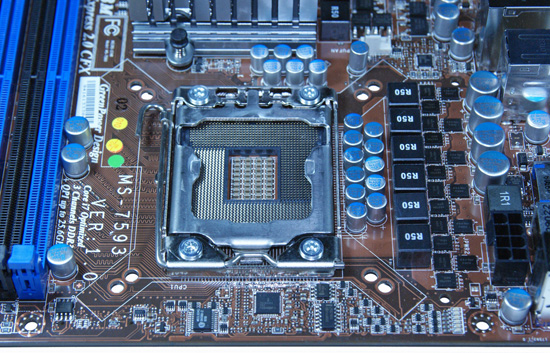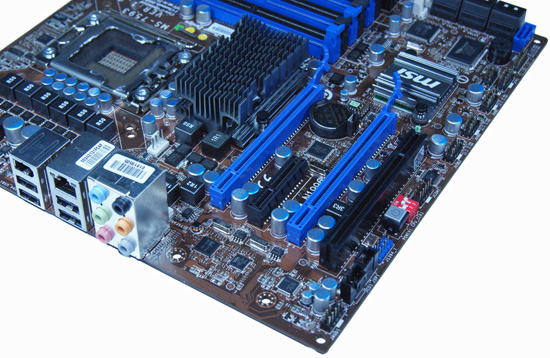Board Layout


Taking a quick tour around this board, we find the overall layout is very good. MSI placed the 24-pin and 8-pin ATX power connectors, floppy/IDE connectors, and the SATA ports near or along the edge of the motherboard. We would have preferred that MSI drop the floppy connector altogether and utilize the space for the two chassis headers. These two fan headers are extremely difficult to utilize with a double slot card like the GTX260 216 or HD 4890 inserted in the first PCIe x16 slot. The rear of the video card covers the fan headers and depending on the card, the first header might not be usable.
A couple of other items we would like to see changed is the color of the PCB and the removal of the Overclocking Block Switch next to the Power On button. Considering MSI’s latest blue on black color scheme for their performance oriented boards, the blue/black on a brown PCB just does not look right on this board. However, in order to meet cost targets this was one of the areas that had to suffer and in the end color really does not affect performance. As far as the overclocking block, we could not find a single opportunity where it provided an advantage over changing Bclk in the BIOS. We think the space could be better utilized for a reset button or clear CMOS button - or both to be honest.
Installation of our peripherals was easy and the board fit well in several case designs. One important item worth mentioning is that our larger air coolers like the Vigor Monsoon III LT fit fine on the board and did not block the first DIMM slot as it does on the ASUS Rampage II GENE board. The back of the board is clean and all of our various air coolers that require a back plate worked fine. Let’s take a quick look at the rest of the board.

The CPU socket area is open and unobstructed for the most part. The socket area is surrounded by the IOH heatsink, MOSFETs, and several capacitors, but we had no issue installing large air coolers or a couple of water blocks. This board features a 6-phase power design with three Low RDS(on) MOSFETs per channel along with the R50 ferrite core closed chokes. The MOSFETs are not passively cooled, though mounting holes are provided on the board if you happen to have a knack for making your own or have an old Eclipse board lying around. We highly suggest active cooling in this area if you are overclocking to ensure stability and longevity. The board features cooling mounting holes for both the LGA775 and LGA1366 heatsink designs. MSI also provides a six light LED setup below and to the left of the 8-pin ATX power connector that indicates the number of power phases in use.

The floppy drive connector, IDE connector, and 24-pin ATX power connector are located along the edge of the board behind the memory slots. Moving to our left, we have the two chassis fan headers that potentially can be blocked by most two slot video cards. Intel’s ICH10R provides support for the six black SATA ports and features RAID 0/1/5/10 capabilities with Intel’s excellent Matrix technology. JMicron’s JMB363 powers the blue SATA7 slot and the eSATA port on the I/O panel. The ICH10R is cooled by a low-rise aluminum heatsink . Along the left edge of the board is the front panel connector, USB 2.0 headers, and IEEE 1394a header.

The expansion slot layout is good considering the limited space. The PCIe x4 slot and PCI slot become physically unusable if dual-slot graphics cards are placed in the PCIe x16 slots. A low-rise aluminum heat sink covers the X58 chipset and provided decent but not spectacular cooling when overclocking. We noticed IOH temperatures hitting 86C when overclocking the board and providing 1.15~1.20V to the IOH to reach Bclk speeds above 220. During normal operation, the IOH temperature fluctuated between 46C~54C. This is another area that could use active cooling from your case fans or a small 40mm fan for heavy overclocking situations.

Last but certainly not least is the I/O panel. There are the standard issue PS/2 keyboard and mouse ports, Gigabit LAN port with LED activity lights, six USB 2.0 ports, one IEEE 1394a port, one eSATA port, and an audio panel.
















25 Comments
View All Comments
aeternitas - Sunday, June 7, 2009 - link
Whats even more strange is thinking a SLi/CF motherboard regardless of size should have on-board video.Not to mention this is an i7 board. You're in the wrong place!
Mr Perfect - Sunday, May 24, 2009 - link
"We expect to see several new uATX designs when P55 hits the market later this year, if not mini-ITX designs based around it."If that's true, then let us know anything you find. While uATX is interesting, gameable M-ITX are unbelievably rare and/or expensive. On a standard ATX board, I use exactly one slot; the x16 PCIe. Needless to say, a M-ITX i5 or i7 board with one of those would be great to play with.
wicko - Sunday, May 24, 2009 - link
Too bad its lowest price is $220 here.. economy+markup = not fun!mmntech - Sunday, May 24, 2009 - link
Business as usual. It's worth noting that $220 CAD translates to $196 US; so we're paying $30 too much. Might still be worth it if it makes a good Hackintosh rig. Be nice to have something that powerful for running Final Cut.Staples - Sunday, May 24, 2009 - link
I am a fan of uATX. I don't desire 5 optical drives nor do I care for more than 2 hard drives. I have bought a few uATX boards in the past but the people who make Intel boards always put G31 or another subpar integrated chipset inside of them. There is no reason that the top of the line chipset can not fit inside a uATX board and work just as well as the crap they put in them today. I definitely welcome someone finally making a desirable motherboard in a uATX board.Per Hansson - Sunday, May 24, 2009 - link
Are we sure these boards support SLI?Crossfire is readily mentioned for these series of boards on MSI's homepage.
But SLI is not mentioned...
Only in the manual but there it looks very generic...
http://eu.msi.com/index.php?func=proddesc&main...">http://eu.msi.com/index.php?func=prodde...cat2_no=...
http://www.msi.com/index.php?func=proddesc&mai...">http://www.msi.com/index.php?func=prodd...2_no=170...
http://global.msi.eu/index.php?func=proddesc&m...">http://global.msi.eu/index.php?func=pro...cat2_no=...
Gary Key - Monday, May 25, 2009 - link
SLI is fully supported with the upcoming Version 3 BIOS, which should be released this week. My FarCry 2 tests were run with SLI enabled. ;)Googer - Sunday, May 24, 2009 - link
Nice price on a motherboard, but the lack of legacy PCI (32) is a deal killer for me. I have an X-Fi that I would like to carry over to my new system.I could buy an Asus XONAR but at $200, I'd rather put that money towards something better and buy a $365 Asus with PCI and more features than buy a new sound card for an MSI board with only 4 expansion slots.
Kibbles - Sunday, May 24, 2009 - link
It has a regular PCI slot. It's the bottom one.plonk420 - Sunday, May 24, 2009 - link
i'm still a bit twirked off by my first negative MSI experience with my X58 Pro... i have a review on The Egg... it all boils down to the shoddy northbridge cooler. google "hot IOH" and you'll see how many people had issues...this LOOKS ok, but i gotta wonder since i've never had an issue with a NB ever before in my life...